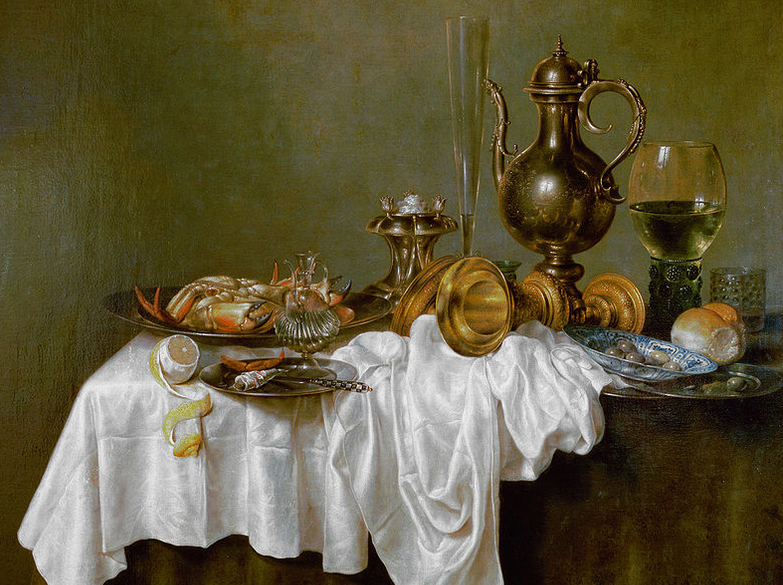Crab for breakfast? 10 facts about a Dutch still life featuring food
 Dutch still life paintings featuring food were all the rage in the Golden Age. Willem Claeszoon Heda (1594-1680) was particularly good at them. Hanneke Sanou looks at the hidden meanings in his Breakfast with Crab.
Dutch still life paintings featuring food were all the rage in the Golden Age. Willem Claeszoon Heda (1594-1680) was particularly good at them. Hanneke Sanou looks at the hidden meanings in his Breakfast with Crab.
All is vanity
1 An ‘ontbijtje’, or small breakfast, is a particular genre in Dutch 17th century still life painting, as were flower pieces, banquet pieces, paintings featuring dead animals and Vanitas paintings. But all were really vanitas paintings, or paintings that reminded the rich burghers of the Netherlands that everything – including their wealth – was transient.
Fishy breakfast
2 This still life is called Breakfast with Crab. Did people in the Golden Age really have crab first thing in the morning? According to food historian Gillian Riley some did indeed have fish, or pie, for breakfast (accompanied by a frothy tankard of beer) but most would have bread and cheese and/or butter, much like the Dutch do now.
Daily bread
3 Bread also features in the painting (right hand side) but it is white bread, a superior product that only the wealthy could afford. It was rye bread for the poor, or porridge or pancakes made of buckwheat, just the kind of thing that would now be considered the healthier option.
Ceçi n’est pas un limon
4 The peeled lemon is not simply a peeled lemon. Like almost everything in Dutch 17th century painting there is a lesson to be learned and thus the lemon symbolises deceptive appearance: beautiful on the outside, sour within. Beware the beautiful looking man/woman for corruption may lurk inside, is the message.
Disarray
5 On the right are some olives in a discarded little Delft blue platter. On closer inspection the whole scene is one of slight disarray, as if the breakfaster, once he’d dismembered the crab (with the utensils in the foreground) and drunk his fill, stood up hastily and ran off to his place of business. In fact, the rumpled table cloth and the up-ended gilded goblets represented another possibility for the artist to showcase his painterly skills.
Who was Heda?
6 The artist in question is Willem Claeszoon Heda about whom not very much is known. He lived and worked in Haarlem and was considered extremely accomplished at rendering the gleam and sparkle of pewter, glass and silver. We would add that he was supremely good at olives as well.
Glass
7 The glasses in the painting will look familiar to many. The Rijksmuseum has a beautiful collection of them. There are three glasses in the painting which, again, doesn’t suggest that three sat down to breakfast but rather that Heda was really good at painting glass. The big one in the middle is called a roemer which is meant for wine, as is the tall Façon de Venise glass. The knobbly bits were meant to keep greasy fingers from slipping, for instance after tackling crab. The small glass is probably a water glass.
Realism
8 The depiction of the gilded goblets, the brightly polished tankard, the silver salt cellar all show how talented Heda was. Apart from acknowledging the usual moral message, the rich buyers of his pictures marvelled at the realism of the artefacts. The greater the ‘artificial miracle’ the greater the appreciation (and presumably the higher the price).
What is that?
9 The rolled up bit of paper on the plate was used for sprinkling herbs. Well, we were wondering about it.
Where is it?
10 If you want to see this particular painting you will have to travel to the Hermitage in St Petersburg. Other still lifes by Heda – and he never painted anything else – can be found in the Rijksmuseum in Amsterdam, the Staatlichen Kunstsammlungen Dresden and the Thyssen-Bornemisza in Madrid.
Thank you for donating to DutchNews.nl.
We could not provide the Dutch News service, and keep it free of charge, without the generous support of our readers. Your donations allow us to report on issues you tell us matter, and provide you with a summary of the most important Dutch news each day.
Make a donation